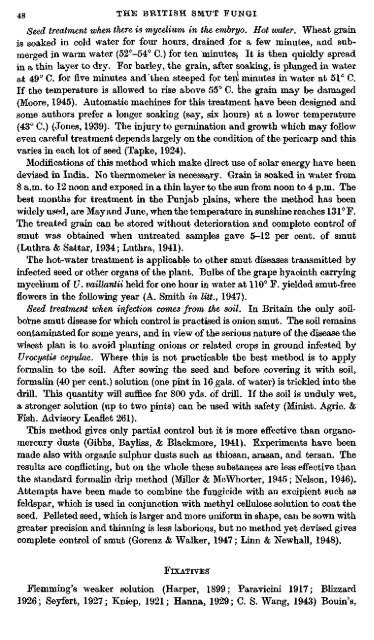nmm sP
nmm sP
nmm sP
You also want an ePaper? Increase the reach of your titles
YUMPU automatically turns print PDFs into web optimized ePapers that Google loves.
48 THE BRITISH SMUT FUNGI<br />
8eed treatment when there is mycelium in the embryo. Hot water. Wheat grain<br />
is soaked in cold water for four hours, drained for a few minutes, and submerged<br />
in warm water (52°-54° C.) for ten minutes^ It is then quickly spread<br />
in a thin layer to dry. For barley, the grain, after soaking, is plunged in water<br />
at 49° C. for five minutes and'then steeped for ten, minutes in water at 51° C.<br />
If the temperature is allowed to rise above 55° C. the grain may be damaged<br />
(Moore, 1945). Automatic machines for this treatment have been designed and<br />
some authors prefer a longer soaking (say, six hours) at a lower temperature<br />
(43° C.) (Jones, 1939). The injury to germination and growth which may foUow<br />
even careful treatment depends largely on the condition of the pericarp and this<br />
varies in each lot of seed (Tapke, 1924).<br />
Modifications of this method which make direct use of solar energy have been<br />
devised in India. No thermometer is necessary. Grain is soaked in water from<br />
8 a.m. to 12 noon and exposed in a thin layer to the sun from noon to 4 p.m. The<br />
best months for treatment in the Punjab plains, where the method has been<br />
widely used, are Mayand June, when the temperature in sunshine reaches 131°F.<br />
The treated grain can be stored without deterioration and complete control of<br />
smut was obtained when untreated samples gave 5-12 per cent, of smut<br />
(Luthra & Sattar, 1934; Luthra, 1941).<br />
The hot-water treatment is applicable to other smut diseases transmitted by<br />
infected seed or other organs of the plant. Bulbs of the grape hyacinth carrying<br />
mycelium of V. vaillantii held for one hour in water at 110° F. yielded smut-free<br />
flowers in the following year (A. Smith in litt., 1947).<br />
Seed treatment when infection comes from the soil. In Britain the only soUbotne<br />
smut disease for which control is practised is onion smut. The soU remains<br />
contaminated for some years, and in view of the serious nature of the disease the<br />
wisest plan is to avoid planting onions or related crops in ground infested by<br />
Urocystis cepulae. Where this is not practicable the best method is to apply<br />
formaHn to the soil. After sowing the seed and before covering it with soil,<br />
formalin (40 per cent.) solution (one pint in 16 gals, of water) is trickled into the<br />
drill. This quantity wiU suf&ce for 800 yds. of drill. If the soil is unduly wet,<br />
a stronger solution (up to two pints) can be used with safety (Minist. Agric. &<br />
Fish. Advisory Leaflet 261).<br />
This method gives only partial control but it is more effective than organomercury<br />
dusts (Gibbs, Bayliss, & Blackmore, 1941). Experiments have been<br />
made also with organic sulphur dusts such as thiosan, arasan, and tersan. The<br />
results are conflicting, but on the whole these substances are less effective than<br />
the standard formahn drip method (Miller & McWhorter, 1945; Nelson, 1946).<br />
Attempts have been made to combine the fungicide with an excipient such as<br />
feldspar, which is used in conjunction with methyl ceUulose solution to coat the<br />
seed. Pelleted seed, which is larger and more uniform in shape, can be sown with<br />
greater precision and thinning is less laborious, but no method yet devised gives<br />
complete control of smut (Gorenz & Walker, 1947; Linn & NewhaU, 1948).<br />
FIXATIVES<br />
Flemming's weaker solution (Harper, 1899; Paravicini 1917; Bhzzard<br />
1926; Seyfert, 1927; Kniep, 1921; Hanna, 1929; C. S. Wang, 1943) Bouin's,

















